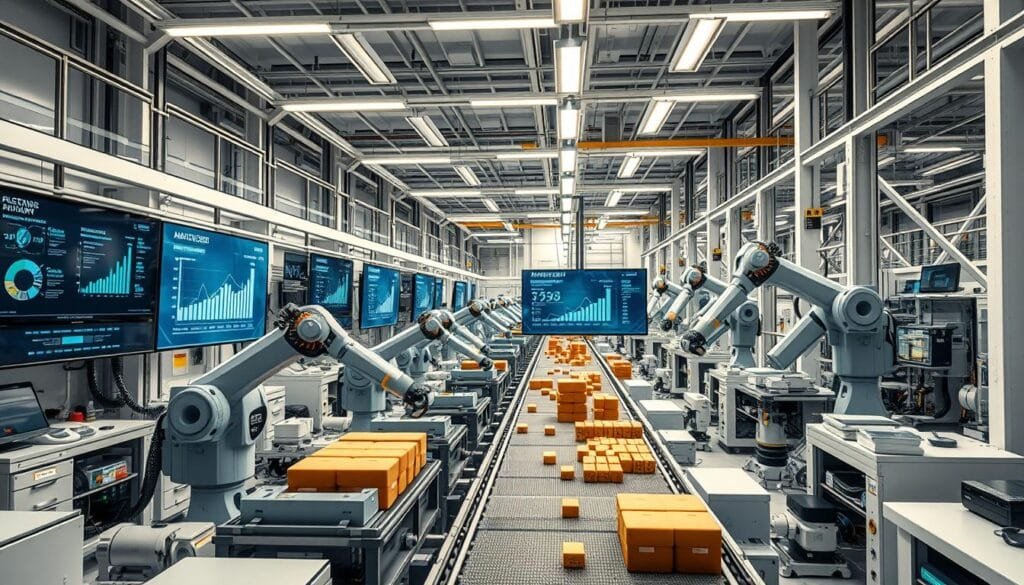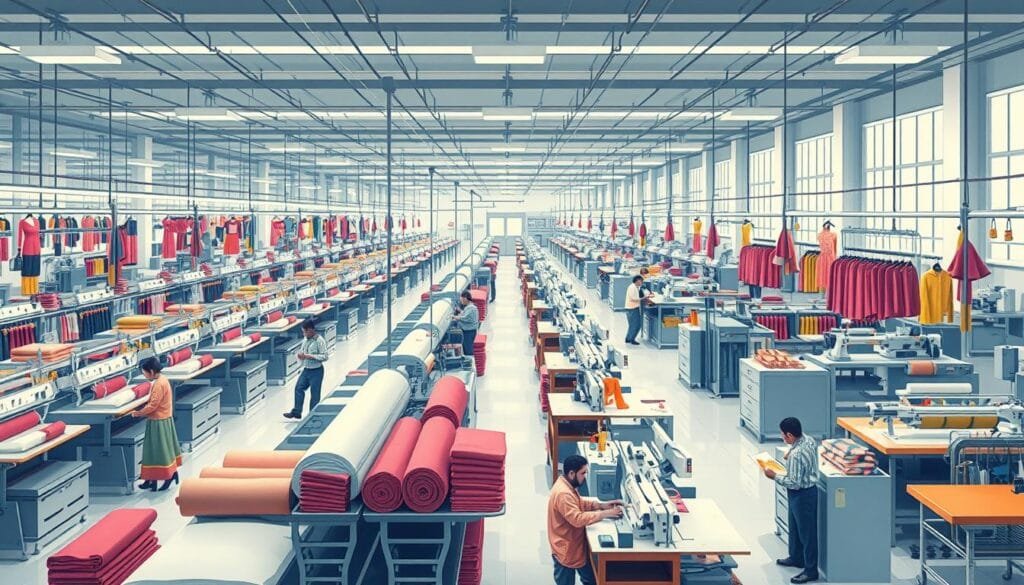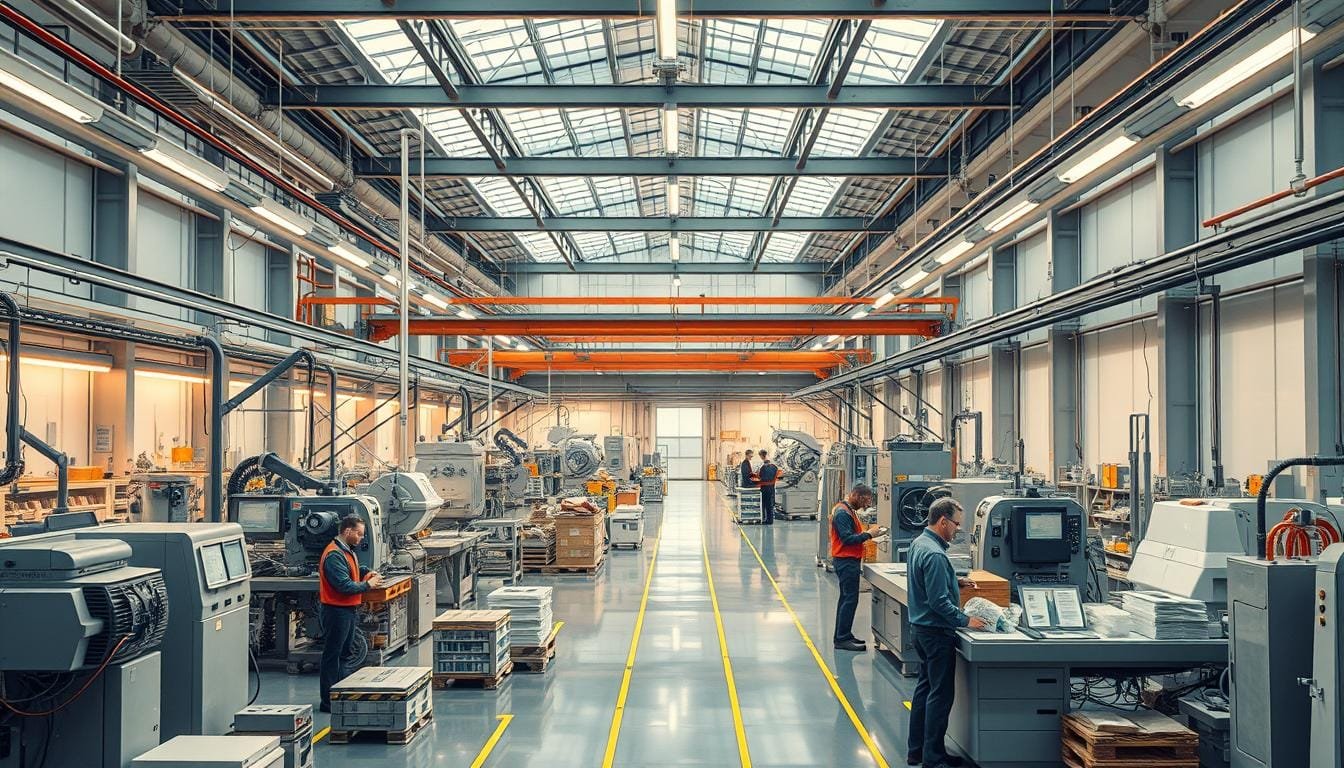Can you picture a business making more but spending less per item? This isn’t just wishful thinking. It’s called economies of scale, a game-changer for many companies. But what does it take for companies to reach this efficiency? And why is it so crucial for their bottom line and staying ahead of competitors?
Understanding economies of scale is vital in today’s market. It’s about making more for less as production ramps up. This key business move can boost profits dramatically. It comes from better efficiency and cutting costs the smart way. As companies grow, they spread fixed costs over more products, reducing the cost for each one. Also, getting better at what they do lowers variable costs.
Big companies have a trick up their sleeve. They buy in bulk and get big discounts. This not only cuts costs but allows them to offer lower prices. This means they can dominate the market by being the cheapest choice.
Economies of scale give big companies a big edge. They can make things cheaper than small firms. This sets them up for success and helps them make more money. Knowing how to save costs, whether through buying more for less, using new tech, or having expert managers, is key for any company that wants to lead.
Key Takeaways
- Economies of scale reduce the per-unit cost of production as output quantity increases.
- Spreading fixed costs over a larger quantity of output decreases the per-unit fixed cost.
- Operational efficiencies lead to falling average variable costs.
- Bulk purchasing can result in volume discounts, further reducing costs.
- Larger companies gain a competitive edge with lower per-unit costs than smaller firms.
- Diseconomies of scale can occur if a business grows too large, increasing unit costs.
- Balancing economies of scale benefits in various divisions is key to maintaining efficiency.
Understanding Economies of Scale
Economies of scale help companies cut the cost of making each item as they make more. This key idea helps save money and enhance profit margins. It is vital for growing a business sustainably. Let’s explore the various aspects of economies of scale further.
Definition and Key Concepts
Economies of scale happen when making more products reduces the average cost for each one. This results from fixed costs, like rent and admin fees, being spread out. As production increases, these costs are split among more items, lowering the cost for each one. For example, a business could decrease its average cost per item by 20% when its production increases from 200 to 1,000 units. This drop lowers the cost from $25.00 to $20.00 per item.
Internal vs. External Economies of Scale
It’s important to know the difference between internal and external economies of scale. Internal economies come from the company itself, often through better management or production. For instance, increasing operational efficiency by 30% can boost productivity. They can also result from large-scale purchasing which lowers stock costs.
External economies of scale, however, impact whole industries. Nearby companies can cut down on shipping and transport costs by up to 25%. Also, new tech or laws can reduce costs for all companies in an industry.
Why Size Matters
The idea of economies of scale shows why being big is essential for competitive advantage. Bigger companies can make more items, reducing the cost per item and offering lower prices. This advantage is clear in sectors with high fixed costs.
Larger firms can also grow their market position and shield themselves from newcomers by offering lower prices and higher quality. For example, using resources more efficiently can help machines run at over 80% capacity. This improves investment payback and boosts profits.
Through smart planning and efficient operations, firms can use scale advantages to grow and remain strong over time.
Strategies for Achieving Economies of Scale
Organizations have many ways to grow and save money. They can buy in bulk, use new technology, and have expert managers. These steps help them spend less, earn more, and stay ahead of others.
Bulk Purchasing
Buying lots at once helps companies save money. Amazon, for example, gets good deals because it buys so much. This method cuts down costs, especially where materials are a big expense.
Technological Advancements
Technology is key for cutting costs. Ford’s assembly line once made cars faster and cheaper. Netflix uses data to pick shows, saving on production costs. Prices that change with demand also help companies adjust quickly.

Specialized Management
Having expert managers for different areas boosts a company’s efficiency. Uber shows this with its management matching drivers with riders well. This improves service and cuts costs by using resources wisely.
What Happens When a Company Achieves Economies of Scale
When a company reaches economies of scale, it can lower its costs. This is done by spreading fixed costs like leasing and insurance over more units. This makes each product cheaper to make as the company grows, giving it a competitive advantage.

Take large distribution chains as an example. They buy stock in bulk, which lowers the price per unit thanks to better bargaining power. This helps them reduce prices for customers, making them more competitive and growing their business.
Companies that use economies of scale often see improved market position and higher profits. They achieve internal economies through management efficiency, which leads to more productivity and better use of resources. This means equipment is used more efficiently, lowering costs and creating a better work environment.
Additionally, companies save money with economies of scale and reinvest it. They might buy better raw materials or improve their products. This not only raises the quality but also strengthens their market position. As they enter larger markets, their brand and prestige improve, reinforcing their market leadership.
Yet, it’s crucial to balance more production with careful management of resources to avoid diseconomies of scale. If a company grows too fast without the right management, costs can increase. So, keeping a balance is key for ongoing growth and efficiency.
| Aspect | Benefits | Indicators |
|---|---|---|
| Cost Reduction | Lower unit costs, Reduced fixed costs per unit | 20% decrease in average cost per unit |
| Competitiveness | Increased customer numbers, Enhanced market positioning | Lower product prices |
| Productivity | Optimized machinery usage, Reduced idle time | Higher overall productivity |
| Savings Reinvestment | Higher quality raw materials, Enhanced product features | Improved product quality |
| Market Prestige | Positive brand image, Increased prestige | Larger market reach |
Examples of Economies of Scale in Action
Economies of scale help industries by lowering costs and boosting profits. We will look at how the fast fashion and manufacturing sectors apply these principles. They gain competitive edges this way.
Fast Fashion Industry
The fast fashion industry shows industry-specific economies well. Brands like Zara and H&M benefit from making lots of clothes. This significantly cuts the cost of fabric and labor per piece. They focus on cost management in fashion. This allows them to offer new, trendy clothes at affordable prices.
Buying materials in large quantities lowers the price for each item. This boosts their profits. Also, using automation and quick design processes cuts down on time and cost needed to make clothes. Thus, fast fashion brands keep offering new styles. This attracts customers who want the latest fashion without paying a lot.

Manufacturing Sector
In manufacturing, companies use economies of scale for manufacturing cost reductions. For example, Ford Motor Company and Intel use modern machines to make lots of products cheaply. Spreading fixed costs, like R&D, over many items reduces the cost for each one.
The assembly line by Henry Ford is a great example. Using big-scale machinery leads to cheaper costs per item. Amazon’s fulfillment centers show how smooth operations can greatly cut down costs.
| Company | Strategy | Result |
|---|---|---|
| Zara | High-volume production, bulk purchasing | Lower fabric and labor costs |
| Ford | Advanced manufacturing technology | Reduced per-unit costs |
| Amazon | Automated fulfillment centers | Lower operational expenses |
| Intel | Mass chip production | Enhanced market leadership |
These cases highlight the power of industry-specific economies. They also show the importance of cost management in fashion and manufacturing cost reductions. Such strategies lead to major competitive advantages. They pave the way for more profits and market control.
Conclusion
In studying economies of scale, we see business success is closely tied to smart scalability. Companies that grow their production and operations can lower their costs per unit. This helps them make more profit. By cutting costs, big companies can set competitive prices. This puts them ahead of smaller businesses.
Bulk buying and better technology help businesses achieve economies of scale. For example, big grocery chains buy food in bulk, saving a lot of money. Manufacturing companies use advanced machines to cut production costs. These benefits help businesses run more efficiently and invest in new ideas. This leads to even more growth.
But growing too big can have its problems, like higher costs from being inefficient. Good management is key to avoiding these issues. Economies of scale are essential for staying competitive and succeeding over time. To learn more about economies of scale, visit this resource. With the right focus on scaling up and efficiency, businesses can overcome obstacles. They can enjoy the full advantages of economies of scale.
FAQ
What is the definition of economies of scale?
Economies of scale mean businesses spend less per item when they make more products. The cost drops because making goods becomes more efficient. Fixed and variable costs are spread over more items.
What are internal and external economies of scale?
Internal economies of scale happen inside a company. They come from better management, production, buying, and technology. External economies of scale happen across an entire industry. They are driven by technological progress and regulations.
Why is company size important for achieving economies of scale?
Bigger companies can spread their costs over more products. This lowers the cost for each item. It gives them a competitive edge over smaller companies.
How can bulk purchasing help achieve economies of scale?
Buying in bulk gets companies discounts. This greatly cuts the material costs for each unit. It makes businesses more efficient and profitable.
In what ways do technological advancements contribute to economies of scale?
Technology can make making products easier and faster. It can also cut down on labor and running costs. This brings down the average costs and boosts productivity, helping achieve economies of scale.
What role does specialized management play in achieving economies of scale?
Specialized management makes sure resources are used well. It helps operations run smoothly and cuts down on waste. Efficient management is key for getting cost benefits and economies of scale.
What happens when a company achieves economies of scale?
A company with economies of scale can charge less than its rivals. This can lead to more market share, better efficiency, and potentially becoming the industry leader.
Can you provide an example of economies of scale in the fast fashion industry?
The fast fashion industry shows economies of scale with its high production volume. This reduces costs for fabric and labor per piece. It allows for quick changes in style at low prices, staying competitive and boosting profits.
How does the manufacturing sector benefit from economies of scale?
Economies of scale benefit manufacturing by using cutting-edge machinery and automation. This produces more goods with lower labor costs and expenses. It increases both efficiency and profits.
